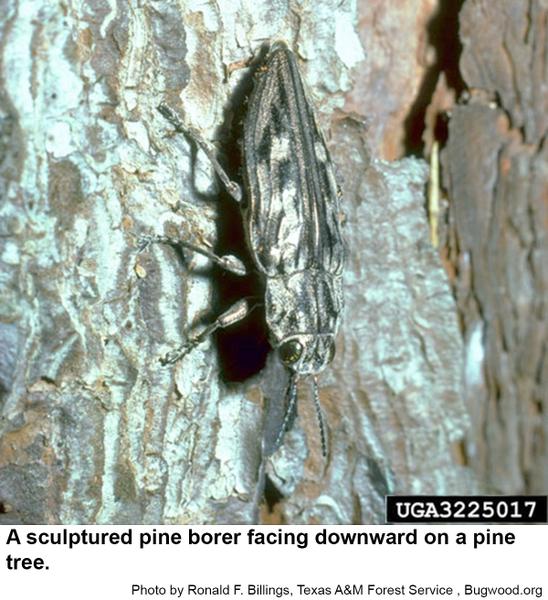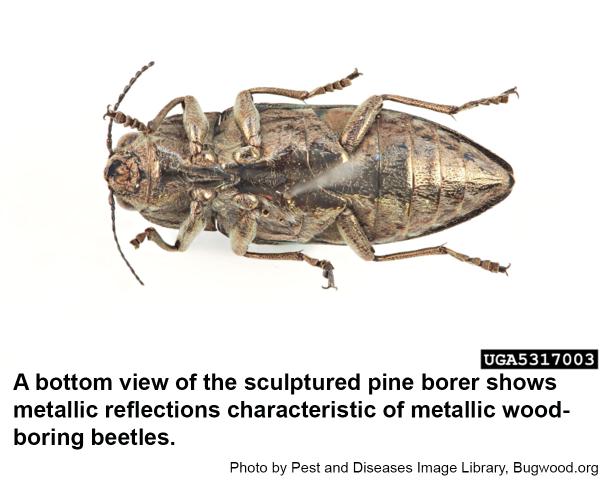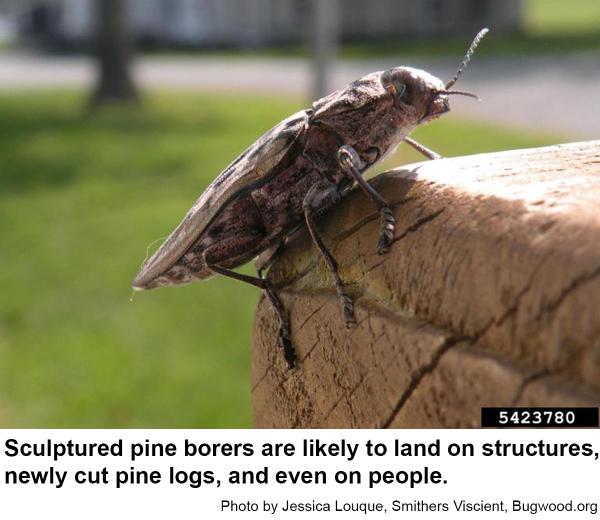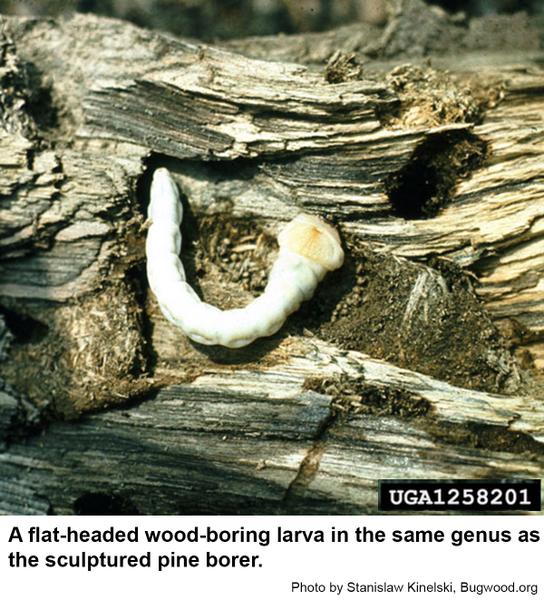Description and Biology
The sculptured pine borer, Chalcophora virginiensis, is also known as the large flatheaded pine heartwood borer, the larger flatheaded pine heartwood borer, the Virginia Pine Borer, and the southern sculptured pine borer. This is the largest metallic wood-boring beetle (flatheaded borer) in the eastern United States (up to 1¼ inch long). These beetles may be seen resting on sidewalks, on walls, and may actually land on people, especially if dressed in bright clothing, which may cause alarm to people intimidated by large insects. The sculptured pine borer breeds mostly in logs, stressed or dead pines, pine stumps, and utility poles. The eggs are laid in cracks, crevices, scars and holes in the bark and the tiny larvae eventually develop into two-inch long, white grubs that have the thorax noticeably wider and flatter than the rest of the body segments (hence the name "flatheaded"). On the top of the wide part is a distinctive Y-shape. Larvae develop under bark, then bore deeper into heartwood where they pupate in a single cell. Grubs may tunnel through wood for two or three years or more. As new adults emerge from the host tree, they leave an elliptical exit hole.
Host Plants
Sculptured pine borers utilize most pines including eastern white pine and all southern yellow pines. They have also been found in bald cypress and reported from spruce. Adults feed on young buds and needles whereas their grubs bore through wood. Along with the southern pine sawyer, the sculptured pine borer is a major reason to salvage and mill pine trees as quickly as possible in the warm months. Both of these borers tunnel into the heartwood and may completely ruin it for lumber uses. These two species often emerge from the walls of new log homes.
Residential Recommendations
If a pine of high aesthetic value is damaged in a landscape, spray its trunk twice or three times during the growing season. A pyrethroid labeled for landscape use is probably the best choice of pesticides. When used as directed, pyrethroids are very toxic to insects but are not particularly hazardous to humans and pets (other than fish-avoid using pyrethroids around pools, ponds, and streams).
References
- Common Name: Woodborer, Scientific Name: Varies, Order: Coleoptera. Drees, B. M. and J. Jackman. 1999. From the book: Field Guide to Texas Insects, Gulf Publishing Company, Houston, Texas.
- Insects of Eastern Forests. Drooz, A. T. (editor). 1985. USDA Forest Service Misc. Publication 1426. 608 pp.
- Reevaluation of Chalcophora angulicollis (LeConte) and Chalcophora virginiensis (Drury) with a review and key. Maier C.A., M. A. Ivie. 2013. The Coleopterists Bulletin 67: 457-469.
- Species Chalcophora virginiensis - Sculptured Pine Borer. Anonymous. No Date. Iowa State University Department of Entomology.
- Woodpecker damage to utility poles: with special reference to the role of territory and resonance. Dennis, J. V. 1964. Bird-Banding, Journal Ornithological Investigation. 35 (4): 225-253.
- Extension Plant Pathology Publications and Factsheets
- Horticultural Science Publications
- North Carolina Agricultural Chemicals Manual
For assistance with a specific problem, contact your local N.C. Cooperative Extension Center.
This Factsheet has not been peer reviewed.
Publication date: June 27, 2016
Reviewed/Revised: Oct. 12, 2019
Recommendations for the use of agricultural chemicals are included in this publication as a convenience to the reader. The use of brand names and any mention or listing of commercial products or services in this publication does not imply endorsement by NC State University or N.C. A&T State University nor discrimination against similar products or services not mentioned. Individuals who use agricultural chemicals are responsible for ensuring that the intended use complies with current regulations and conforms to the product label. Be sure to obtain current information about usage regulations and examine a current product label before applying any chemical. For assistance, contact your local N.C. Cooperative Extension county center.
N.C. Cooperative Extension prohibits discrimination and harassment regardless of age, color, disability, family and marital status, gender identity, national origin, political beliefs, race, religion, sex (including pregnancy), sexual orientation and veteran status.




